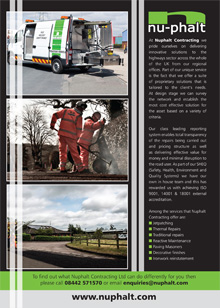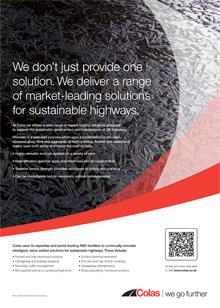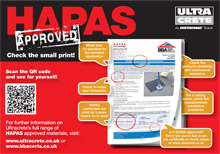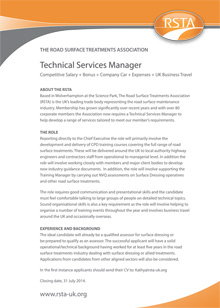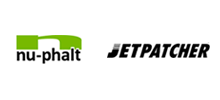eNews
Issue 12 - Spring 2014
RSTA Conference Report
CONFERENCE CALLS FOR NEW THINKING FOR ROAD MAINTENANCE
With the need to do more-for-less road maintenance needs a new way of thinking. The 2014 Road Surface Treatments Association road industry conference outlined new and innovative approaches to efficient road maintenance funding and delivery.The scene was set by Paul Goosey, RSTA Chairman, who explained that new ways of doing more-for -less is essential if highway authorities are to properly maintain their most valuable asset: the road network. He said: “Central government gradually removing their financial support to local authorities over the next few years will leave a funding gap of up to 30 per cent. Therefore, innovation to find ways to overcome this shortfall is now needed more-than-ever otherwise the road network will deteriorate even more rapidly than witnessed in recent years.”
The potential efficiencies of examining and implementing a new approach was underlined by Stephen Child, Engineering Manager and ADEPT and HMEP Advocate. He outlined how the Isle of Wight had determined that the best way forward was to award a PFI 25 year contract that covered the rehabilitation and maintenance of all of the islands highway related network including associated infrastructure assets such as car parks, street furniture and traffic signs. For the first seven years of a Core Investment Programme to bring the road network up to a good standard is being implemented. This will be followed by 18 years of maintenance operations. “The advantage of this approach is the forward planning that ensures that the road network is able to meet performance requirements in 25 years hence”, said Child. “It also ensures that no work is done too early or, importantly, too late. A further advantage for the local authority is that there is no ‘cash splash’. The contract has a predetermined budget and all the risks are with the contractor. Above all, the PFI approach demands good asset management and facilitates good asset management.”
For Jason Russell, Highways Director for Surrey County Council, greater collaboration is the way forward. He explained the challenges and opportunities with establishment of South East 7 – a collaboration between Brighton and Hove, East Sussex, Hampshire, Kent, Medway, Surrey and West Sussex local authorities. The challenges included the disinclination amongst councils against joint contracts and the diverse range of priorities and objectives. “However, one common need that brought them together was the need to save money,” said Russell. The potential opportunities for collaboration were demonstrated by a 2011 trial examining the development of a common supply chain for asphalt. This saw the rationalisation of 130 different asphalt mixes and specifications to a more manageable number. Following this trial a 5-year capital programme was developed. Entitled ‘Operation Horizon’, it aimed to encourage long-term planning and an outcome focussed approach that resulted from clients, service providers and specialists all collaborating to deliver solutions. The use of collective purchasing power provided cost savings of 15 per cent or £8 million per year. “To succeed, collaborative working requires a coming together of objectives, the development of a strategic approach and the implementation of long-term thinking plus the exchange of data and experience. This enables challenges to be addressed with effective efficiency solutions, said Russell. “SE7 represents a new vehicle through which councils are responding proactively to the new working context.”
Greater collaboration is just one of the key recommendations in the arsenal of efficiency tools that have been developed by Highways Maintenance Efficiency Programme (HMEP) explained Steve Kent, President of ADEPT and Strategic Advisor Cheshire West and Chester Council. These tools, such as the Client/Provider Toolkit, Collaborative Alliance Toolkit and LEAN Toolkit, are helping local authorities make considerable efficiency improvements and achieve significant cost savings. However, whilst many local authorities have adopted and used the tools others are proving reluctant to do so have yet to do so. “HMEP and asset management represent new thinking, shared best practice, and the establishment of positive dialogue and exchange of ideas between client, contractor and sub-contractor,” said Kent. “If the potential for a better maintained road network is to be realised then all highway stakeholders from national and local government to industry contractor and supplier must be ready and willing to sign-up to new thinking and best practice.”
New thinking can be applied to strategic planning and, as Benoit Chalet, Zone Manager for Acmar France demonstrated, to processes and products. The implementation of CE Marking throughout Europe can underlined the need for consistent quality of surface dressing. Access to accurate information is crucial to determine correct site preparation, material mix, application and installation and long-term assured performance. Set against this background, Acmar has developed a ‘jobs data follow-up’ tool. An analytical data storage module is positioned on the plant and provides real-time data on the surface dressing job including location details, weather conditions and ambient temperature, road preparation and dressing type. The information is exported to give accurate project site data and installation feedback. “Having the right information at the right time is essential for efficient scheduling and delivery of surface dressing projects”, said Chalet. “It ensures better use of materials and equipment, saves money and time, and is integral to proper asset management.”
back to contents »
Copyright 2014 Road Surface Treatments Association. www.rsta-uk.org
